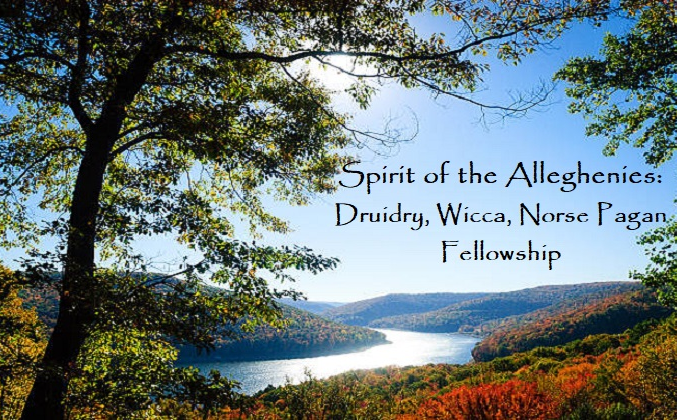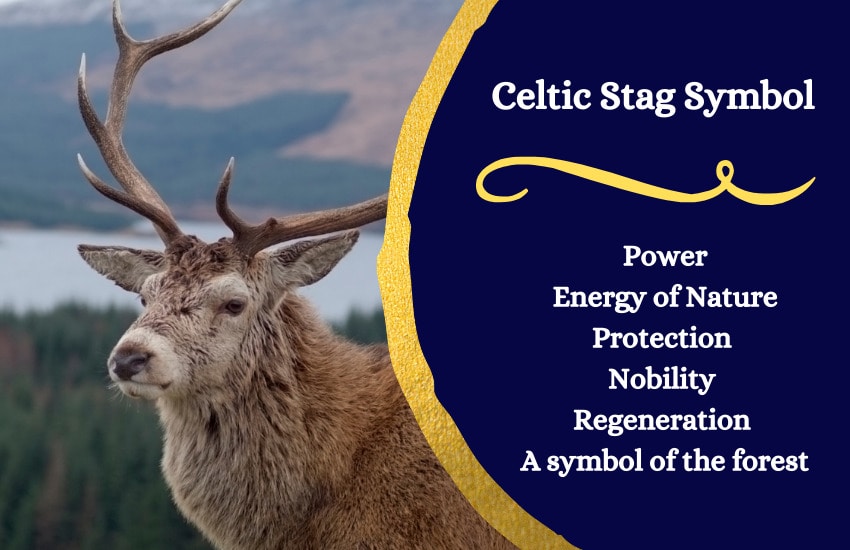
Perhaps the most important prey animal hunted in ancient times, the stag served as a great provider for our ancestors. His hide covered our earliest homes and provided material for clothing, his meat sustained us during the difficult winter months, and his bones were fashioned into tools both sacred and ordinary.
Celtic Symbolism:
“I am the stag of seven tines.”
~ Amergin
The stag holds a sacred position in Celtic cosmology. The majestic stag’s beauty, grace, and power complements the speed, agility, and cunning of the wolf, and so these two iconic symbols of wilderness represent the natural balance between predator and prey. This dynamic is displayed on the Gundestrup Cauldron, a beautifully decorated Iron Age silver cauldron dating from between 200 BCE to 300 CE discovered as part of a sacrificial cache in a peat bog in Denmark. One of the large plates making up the cauldron, the Celtic ‘Horned God’ Cernunnos, Lord of Animals and patron of sexuality, fertility, and hunting is displayed seated between a stag and a wolf, keeping the balance between predator and prey. Antlers grow from the God’s head, with seven tines on each, likely symbolic of the four cardinal directions united with the three levels of the Universe. He is also worshipped as the “Lord of the Wild Hunt,” who carries the spirits of the dead to the Otherworld. Hence, the stag is also connected to the Otherworld and may be seen as an initiator.1 The epic story of the Battle of the Trees begins with the hunter (and later divine ploughman) Amaethon hunting a stag, which disappears into a cave leading to the Otherworld. Amaethon follows the stag and soon finds himself in the company of Arawn, Lord of Annwn, who sometimes wears a crown made of antlers and rides upon a great stag. Thus, the stag serves as a messenger between Earth and the Otherworld, and is associated with the Samhain, the Celtic New Year.

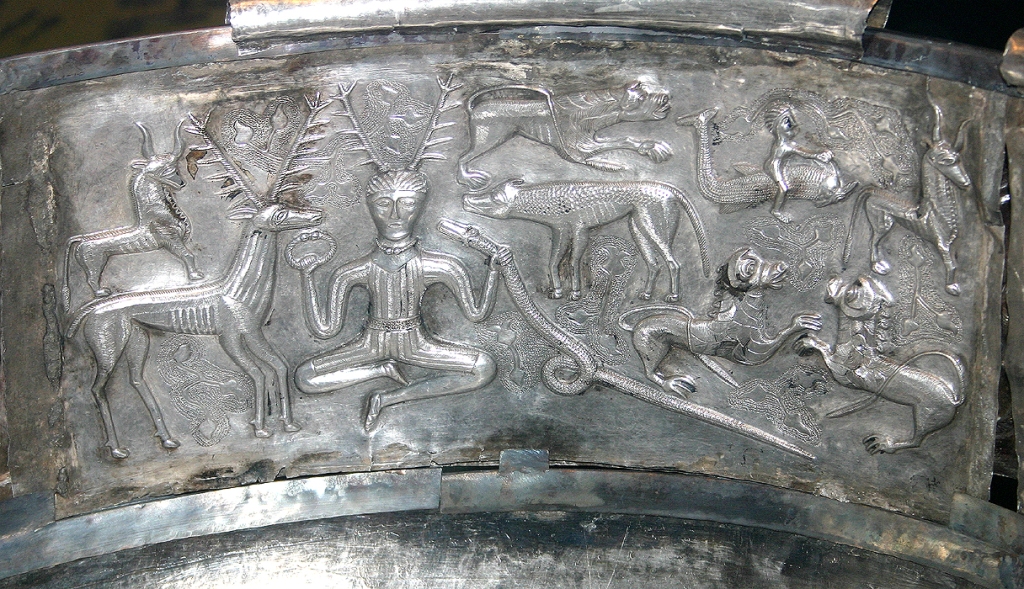
In Welsh legend, the stag is one of the five oldest animals in the world. In the Arthurian tale Culhwch and Olwen, Arthur’s nephew Culhwch falls in love with a giant’s daughter named Olwen. The giant sets thirty-nine impossible tasks for Culhwch to perform before he may marry his love. Among these tasks, Culhwch must free Mabon, the embodiment of divine youth from his prison in the Under-world. This is no small feat, for Mabon has not been seen since he was abducted from his mother three days after his birth, an event which happened in distant memory of the oldest living man. The company therefore seeks the oldest animals in Albion in hopes that they might know Mabon’s location. They travel to the Blackbird of Cilgwri, who leads them to an animal yet older, the Stag of Redynfre, who in turn directs them to the venerable Owl of Cwm Cowlyd. The owl tells them of many things which have come into the world and passed away long after the disappearance of Mabon. The owl then directs them to the Eagle of Gwern Abwy, who takes them to the oldest animal in the world, the Salmon of Llyn Llyw. The salmon, their last and best hope, takes them down the river to Gloucester where Mabon is being held in castle prison. With the assistance of Arthur and his knights, Culhwch liberates Mabon and completes the task. These five “oldest animals” may represent an ancient totemic clan system in Wales / Britain. It unquestionably places the stag as one of the central animals in Celtic lore and thus in the Druidic spiritual tradition.2

The ancient connection of the stag to Celtic and pre-Celtic peoples in the British Isles is further evidenced by the fact that humans have been dressing as stags or wearing antlers to represent nobility or fertility for at least 9,500 years. Excavations at Star Carr in Yorkshire revealed numerous Stag skulls with antlers that had been hollowed out to be worn by shamans for transformative ritual. Legend holds that Irish High Kings were coronated while wearing stag antlers before the Lia Fáil coronation stone at Tara.
Norse Symbolism
Beyond the many similarities between Celtic and Norse stag traditions, there is a curious legend about four stags inhabiting the Norse World-Tree. Norse cosmology holds that there are nine realms, or dimensions of reality, organized along the roots, trunk, and branches of a cosmic ash tree called Yggdrasil. A gigantic eagle named Hræsvelgr (Corpse-eater) sits atop the tree and knows all that passes among the nine realms via a hawk named Veðrfölnir (Wind-witherer) who daily flies through-out the realms and reports to Hræsvelgr. At the base of Yggdrasil lies the dragon Níðhöggr (Malice-striker), who gnaws upon the roots, threatening to kill the tree and end creation.

From Grímnismál: The Speech of the Masked One:
“33. Hirtir eru ok fjórir,
þeirs af hefingar á
agaghalSir gnaga:
Dáinn ok Dvalinn,
Dvneyr ok Dvraþrór.”
Translation (1851 C.P. in The Yale Magazine, Vol. 16 “The Song of Grimner”):
“Also four stags there are—
Dainn, Dualin,
Duneyrr,’and Durathror—
Who, twisting their necks,
gnaw the boughs of the ash.”3
Four ancient stags browse the foliage of the upper branches of Yggdrasil, eating away the buds (hours), blossoms (days) and branches (seasons).4 The stags have Dwarven names: Dainn (Death); Dvalinn (Sleep); Duneyr (Silence); Durathor (Noise or Din). Dvalinn is recorded as being the son of a great Drwaven king, while Dainn was once an Alfhein lord. One interpretation of this legend is that our finite time on Midgard (Earth) is devoured as we sleep or lie dead, and it doesn’t matter whether we pass our time in silent contemplation or in the noisy business of life. The stags eat our hours, days, and seasons, but in doing so they prepare the way for new growth, reminding us that at every moment something is passing from our world as another is arriving, endless cycles of birth, death, and birth anew. The four stags perform another critical function as the creators of the four winds. As the great eagle Hræsvelgr beats his wings and generates the life-energy that sustains Yggdrasil, the energy is caught up in the stag’s antlers and directed to the four cardinal directions as wind. In the Prose Edda book Gylfaginning, four dwarves support each of the four directions, together holding up the dome of the sky, which was created from the skull of the Jötunn, Ymir. The dwarves are named Norðri (North), Suðri (South), Austri (East) and Vestri (West), their etymology directly deriving from the Indo-European words for the four directions. Dwarves are creators in the Norse myths, fashioning all manner of magical items for the gods and the other races. Here, the four stags with Dwarven names are directly related to the four cardinal directions as the originators of the four winds that blow from realm to realm. Those who learn to wield magic can learn to “ride” the winds and traverse the nine realms.5
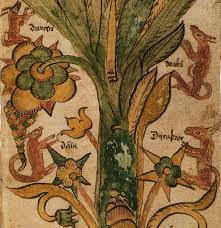
Another noteworthy stag in Norse tradition is Eikthynir (Oak-thorny), who stands atop Odin’s hall of Valhalla and browses on the upper branches of the Læraðr tree, most likely a pseudonym for Yggdrasil. Water or dewdrops drip from Eikthynir’s antlers and fall into the well Hvergelmir in Helheim, from which they form several rivers: Síd, Víd, Søkin, Eikin, Svöl, Gunnthrá, Fjörm, Fimbulthul, Gípul, Göpul, Gömul, Geirvimul, Thyn, Vín, Thöll, Höll, Grád, Gunnthráin, Nyt, Nöt, Nönn, Hrönn, Vína, and Vegsvinn.6
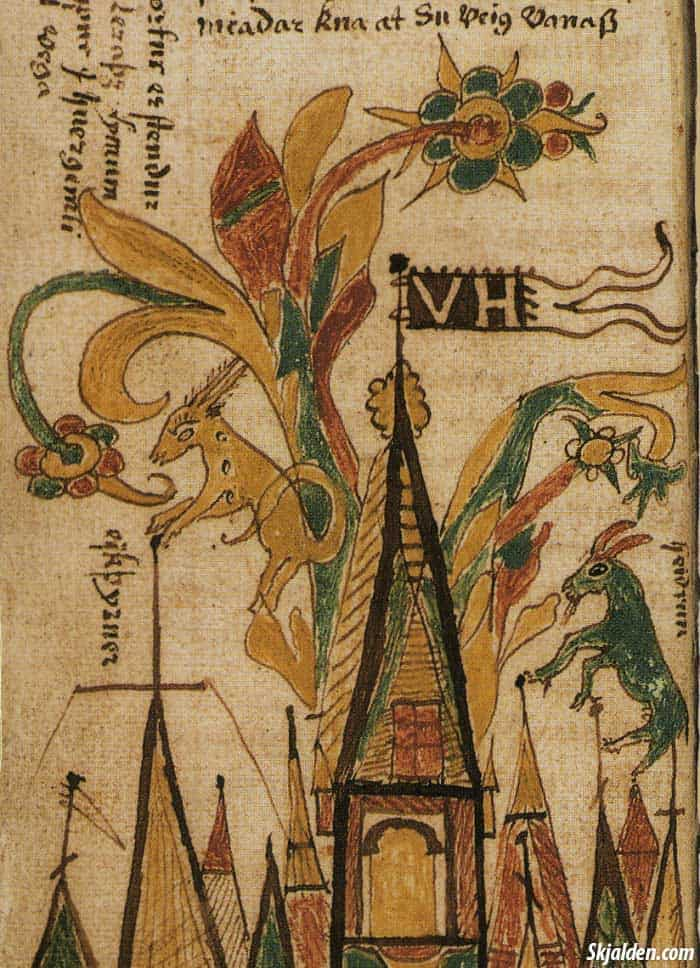
Stag Connections
Power, Pride, Grace, Independence, Beginnings, Fertility, Sexuality, Majesty, Integrity, Dignity, Purification, Sacrifice, Balance, Harmony, Birch Trees, Beltaine, Samhain, Otherworld, Faeries, Green Man, Cernunnos, Herne the Hunter, Merlin, King Arthur, Pennycress (Deer’s Pot-Herb), Mountain Sorrel (Deer’s Sorrel), Common Asparagus (Deer’s Son’s Leek), Heathrush (Deer’s Oats), Deer’s Tongue, Yggdrasil, The Four Winds, Valhalla, Morning Dew, Rivers.7
Below is a link to an amazing stag chant called “Hoof and Horn” written by Ian Corrigan and performed by Kate West:
Footnotes:
[1] https://www.worldhistory.org/Gundestrup_Cauldron/
[2] https://folklorethursday.com/folktales/the-owl-of-cwm-cowlyd-and-the-oldest-animals-in-the-world/
[3] http://www.germanicmythology.com/PoeticEdda/GRM33.html
[4] https://druidry.org/resources/stags-and-deer
[5] http://galdrtanz-runedance.blogspot.com/2013/02/yggdrasil-world-tree.html
[6] https://skjalden.com/heidrun-and-eikthyrnir/
[7] The Druid Animal Oracle: Working With the Sacred Animals of the Druid Tradition,” by Philip and Stephanie Carr-Gomm and illustrated by Bill Worthington, Simon and Schuster, 1994.
